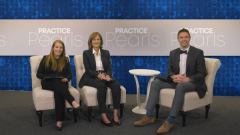
Optimizing Current Therapies and Maintaining Quality of Life in HR+/HER2- Breast Cancer Treatment
Drs Haumschild, Moore, and Dent provide strategies to optimize current and forthcoming HR+/HER2– breast cancer therapies while preserving patients’ quality of life.
Episodes in this series

Ryan Haumschild, PharmD, MS, MBA: Dr Dent, we consider a lot of innovative therapies. There are a lot of exciting things. But I want to know from you first, and then I’m going to come back to Dr Moore on this one. What are the most promising developments you see on the horizon for HR [hormone receptor]–positive, HER2-negative patients? It could be screening, genomic markers that you’re excited about, or overall treatments.
Susan Faye Dent, MD, FRCPC, FICQS: That’s a good question. We have multiple therapies, and we’ve talked about different lines of therapies. It’s important to understand which therapy is going to work best in that individual. For instance, with CDK4/6 inhibitors, we don’t truly understand who will benefit the most or who would develop resistance. Wouldn’t it be great if we had some marker that could say whether a person is going to benefit the most from a CDK4/6 [inhibitor] or will be less likely to develop resistance? We’re learning more about markers, but we still have a long way to go.
Likewise, wouldn’t it be great if we could predict who could continue on the backbone of a CDK4/6 inhibitor with just changing the endocrine therapy? That would also be great in terms of keeping patients on that therapy for as long as possible. Understanding that when you say markers, we’re still in the early days of understanding who will respond best to what therapy. That’s what it’s all about: maximizing the therapy in the patients who are going to benefit most, then understanding a bit more about the different pathways and upper regulation of pathways.
We’ve heard about different targets, but how do we sequence those targets? There’s still a lot more that needs to be done in clinical research looking at the optimal sequencing of those therapies, [ideally] based on markers that can predict who might benefit. We have lots of therapies, which is great, but now we have to figure out who they’re going to work best in and how we sequence those therapies.
Heather N. Moore, PharmD, BCOP, CPP: I completely agree. We have a lot of great therapies, but just like Dr Dent mentioned, it’s going back to optimization of those therapies. We have efficacy, but how do we create or improve on those durable responses to have therapy that lasts longer? Something that’s also nice and has been somewhat of a transition is looking at quality of life. A lot of studies have looked at not only efficacy but quality of life within the patients who are in those clinical trials or on those therapies, acknowledging that if a patient can’t stay on therapy or if it’s significantly reducing their quality of life, is the benefit as great as we think it is based on the efficacy alone? We’re also circling back to the general toxicity of those therapies and having some of these trials look at how we improve on that. I essentially agree with everything that Dr Dent said and overall optimization.
Ryan Haumschild, PharmD, MS, MBA: This has been such an informative and inspiring discussion about HR-positive, HER2-negative patients with breast cancer and the different therapies. I’ve learned a lot and enjoyed our discussion around toxicity management, the best way to sequence patients, future literature, and future FDA approvals that we can [take advantage of to] better treat these patients. Before we end, I want each of you to walk me through your key takeaways around the unmet needs and future directions for an HR-positive, HER2-negative patient and what some of those key takeaways should be for those who are viewing [and] saying, “What do I need to pay attention to? What are the key takeaways that I need to be thinking about?” Dr Dent, let’s start with you, and then we’ll finish with Dr Moore.
Susan Faye Dent, MD, FRCPC, FICQS: That’s the question of 2022, because as clinicians, we want to maximize the benefit. If we can take a therapy like CDK4/6 inhibitors and maximize the duration of benefit for that individual while managing and minimizing toxicities, that would be great. Can we keep them on it even longer? Then once they progress, transitioning them to a therapy that they’ll respond to, [ideally] based on a target that we’re able to measure, while at the same time managing and keeping their quality of life as high as possible and minimizing toxicity. What should we be looking for in 2022? More and better therapies while building on the backbone that we already have and keeping in mind that it’s about quality of life, not always quantity of life, and that we have to keep that in mind for our patients.
Heather N. Moore, PharmD, BCOP, CPP: I don’t know whether I can add to that. That’s fairly succinct. I agree with all those comments. It’s more going from standard chemotherapies to more targeted therapies to optimizing therapies and making them more patient specific. It’s about how we fit this drug to this patient and vice versa. The goal…in the upcoming years is more targeted therapies that specifically fit these patients whom we’ve identified may receive the best benefit.
Ryan Haumschild, PharmD, MS, MBA: Thanks to all of you for this rich and informative discussion. I’d like to thank Dr Moore and Dr Dent for all the information you displayed, as it was very helpful. We thank our viewing audience. We hope you found this Pharmacy Times® panel discussion to be useful and informative.
Transcript edited for clarity.
Newsletter
Stay informed on drug updates, treatment guidelines, and pharmacy practice trends—subscribe to Pharmacy Times for weekly clinical insights.







































































































































































































